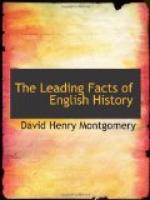Later, a fourth court, that of Chancery (see S145, and note 1),
over which the Lord Chancellor presided, was established as a court of appeal and equity, to deal with cases where the common law gave no relief.
148. Trial by Battle.
In the administration of justice, Trial by Battle was introduced in addition to the Ordeal of the Saxons (S91). This was a duel in which each of the contestants appealed to Heaven to give him the victory, it believed that the right would vanquish. Noblemen[2] fought on horseback in full armor, with sword, lance, and battle-ax; common people fought on foot with clubs.
[2] See Shakespeare’s “Richard II,” Act I, scenes i and iii; also Scott’s “Ivanhoe,” Chapter XLIII.
In both cases the combat was in the presence of judges and might last from sunrise until the stars appeared. Priests and women had the privilege of being represented by champions, who fought for them. Trial by Battle was claimed and allowed by the court (though the combat did not come off) as late as 1817, in the reign of George III. This custom was finally abolished in 1819.[3]
[3] Trial by Battle might be demanded in cases of chivalry or honor, in criminal actions, and in civil suits. The last were fought not by the disputants themselves but by champions.
149. Divisions of Society.
The divisions of society remained after the Conquest very nearly as before, but the Saxon orders of nobility, with a few very rare exceptions, were deprived of their rank and their estates given to the Normans.
It is important to notice here the marked difference between the new or Norman nobility and that of France.
In England a man was considered a noble because, under William and his successors, he was a member of the Great or National Council (S80), or, in the case of an earl, because he represented the King in the government of a county or earldom.
His position did not exempt him from taxation, nor did his rank descend to more than one of his children. In France, on the contrary, the aristocracy were noble by birth, not office; they were generally exempt from taxation, thus throwing the whole of that burden on the people, and their rank descended to all their children.
During the Norman period a change was going on among the slaves, whose condition gradually improved. On the other hand, many who had been free now sank into that state of villeinage (S150) which, as it bound them to the soil, was but one remove from actual slavery.
The small, free landholders who still existed were mostly in the old Danish territory north of Watling Street (see map facing p. 32), and in the county of Kent on the southeast coast of England.
150. Tenure of Land in the Norman Period; Military Service, Feudal Dues, National Militia, Manors and Manor Houses.




